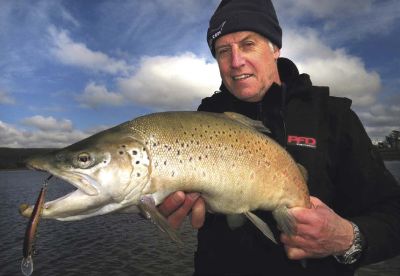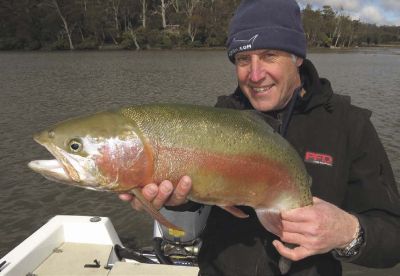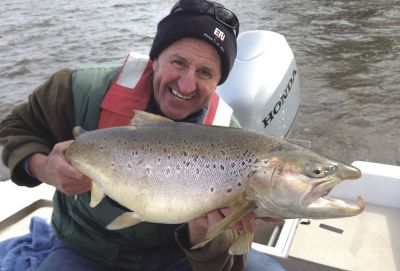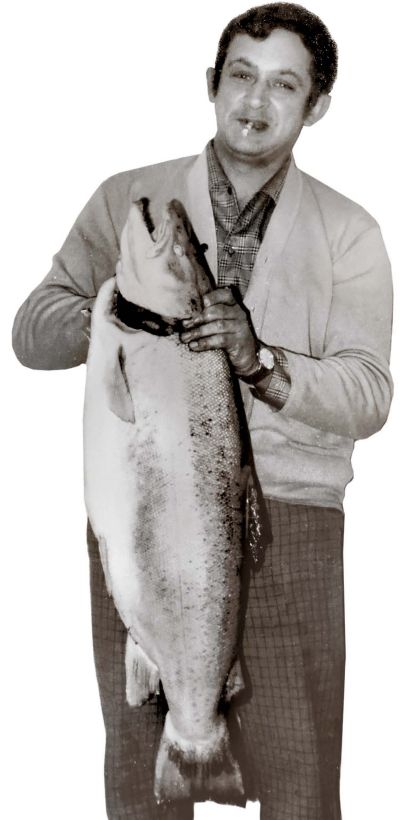 Presented from Issue 112, October 2014
Presented from Issue 112, October 2014
Almost certainly home to Tasmania’s biggest trout, Lake Crescent is seeing a resurgence in popularity. A chequered past has seen this lake through quite a few ups and downs.
For many years it was a hunting ground for anglers using galaxiids for bait. They would row the bait out on a ‘long line’ then it was back to a camp on the shore and wait. Often enough nothing would happen, but occasionally the reward would be massive.
In 1973 Billy Zotch landed a huge fish that after gutting, reportedly weighed 33 pounds. A report at the time said Billy had to kill and gut it to stop the fish flapping around and swamping the small boat they were in. The massive brown was caught on a Big Bat lure.
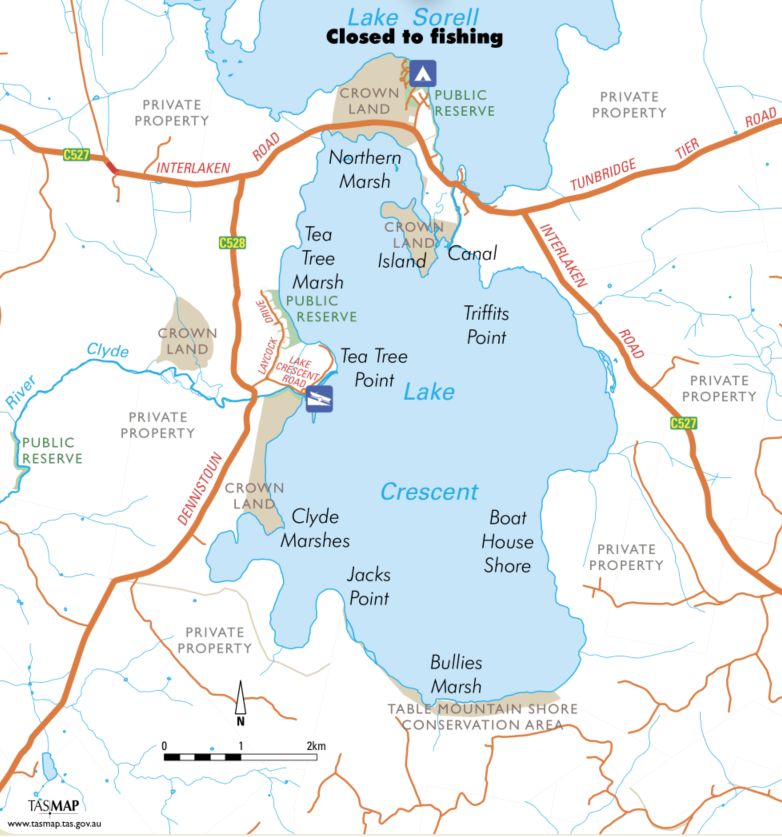 |
| Click on the map for a larger view |
Moving on a few years carp were found in Crescent in 1995 and it was closed while an ambitious attempt was made to remove all carp from the 2306 ha lake. Many had their theories including poisoning it with Rotenone, despite the fact that there was not sufficient quantities of the poison available in the World.
Using a labour intensive fishing program, with traps and nets,Tasmania’s Inland Fisheries Service did the almost impossible and declared Lake Crescent free of carp in 2009, after a lone female carp was caught in December 2007 and further fishing showed that the eradication had been completed. It was an outstanding success that had not been achieved on that scale before anywhere else in the World.
The lake was reopened in 2004 and apart from a short burst of pressure initially drought conditions hampered an improvement in water clarity. For ten years it has not had more than a regular handful of anglers who have tried their hand at catching the large trout the lake is known for. It has been rare to see more than two or three cars at the car park and ramp and it seems shack owners were really the only regulars.
Regulations have been changed. Bait fishing is no longer allowed, nor is fishing at night and camping is not encouraged. However one thing that hasn’t changed is the size of the fish.
There are some monsters still lurking in the constantly turbid water. The water is usually clearer near the shore and turbidity drops off dramatically from the front of the marsh to the back where trout penetrate early in the season while lake levels are high and the aquatic plants are sparse. There are channels and depressions that the trout use to navigate back into the marshes and it is worth exploring to find these “highways”.
When full the lake only averages 1.5 - 2 metres in depth and will stir up during wind events. Periods of calm weather allow the water clarity to settle and provide the best opportunity to target trout. Similarly, protected shorelines are best targeted. The lake provides water for downstream use and when water is being released fish are drawn into the outflow canal to focus on the food that is being drawn through. Another area to keep an eye on is the Interlaken Canal between Sorell and Crescent.
This channel was deepened during the carp program and has open banks allowing easy walking down from the road. When water is being released from Lake Sorell the large trout are attracted into the flow in search of food. The mouth of the canal where it enters into Crescent proper is also worth exploring at this time. Be aware that the canal is open only below the Interlaken Road Bridge.
The turbid water is not attractive to many Tasmanian’s who are used to water that is often crystal clear. But it does not affect the fish and they seem to find plenty of food and stack on the weight. Most of the food is either in the surrounding marshes or close to the rocky shore. However, at times huge trout can be seen porpoising after galaxias all over the lake when the lake calms off.
One of the foods the obese trout eat are the golden galaxias Galaxias auratus and these are listed as endangered under the EPBC Act as they are geographically confined to lakes Crescent, the close by Sorell and adjacent streams. The golden galaxias generally grows to about 140mm, but can grow to 240mm. They prefer rocky areas which provide protection as well as breeding opportunities, but they can be found all over the lake. They spawn in late autumn-winter when the water temperature is between 2-7°C. They exist in huge numbers in Crescent and have coexisted with trout for well over 100 years.
There are no other galaxias species in Lake Crescent. They generally only live for 3-4 years and although hardy can often be seen dead on the surface. This may be from a variety of reasons from being bashed on the shore during strong wind events, fish attack or just old age. They are quite aggressive feeders themselves and have been observed to cannibalise on smaller specimens of their species as well as feeding from the surface on terrestrials like gum beetles. This exposes them as a high calorie prey item for trout.
Other foods the trout eat are stick caddis, snails, mudeyes, frogs and beetles.
If you spend any time on the lake you will see, and hear some huge fish splashing, rolling and boofing after the galaxias. Never pass by the chance to put a few casts in the vicinity. The result may be a snag like hookup.
Where to fish
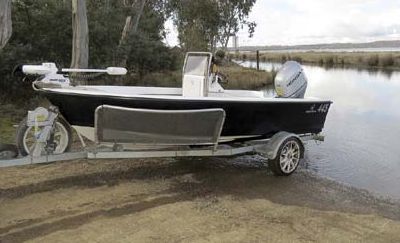 |
| The excellent concrete boat ramp at the canal. |
Much of the western and northern side are covered in marshes. Whilst some of these can accessed from the shore it is best fished from a boat. Landing a big fish while wading in the marshes can be a special challenge. From the shore there are a couple of good options. The first is the outflowing canal where the boat ramp is situated. It is easy to walk along and both the canal and mouth can be productive. From the mouth and north there is plenty of shore you can fish around Tea Tree Point and along to the shack shore and Tea Tree Marsh.
The other prime shore fishing area is the canal between Sorell and Crescent. It is open to fishing and at a high level this it can also give up some very good fish. Walking down the western side of the canal is best and when you reach the end you can wade to the island fish around much of that as well.
From a boat all the lake can be accessed, but beware as being shallow it can get rough quickly. The Northern Marsh has some great gutters and a boat is essential here. The island has some great shores and it is worth spending plenty of time here. You should cast your lures or soft plastics in very close to shore as this is often where the spawning galaxiids are.
Likewise any of the rocky shores can be great as explained re the galaxiids.
Fish along the front of any of the marshes and make sure you put a few casts into any opening in the reeds and weeds. Every now and then put a cast out into the open water as well.
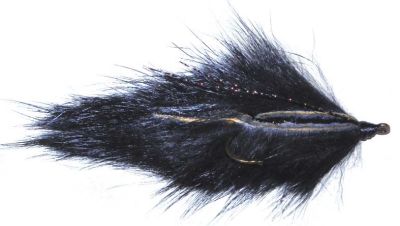 |
 |
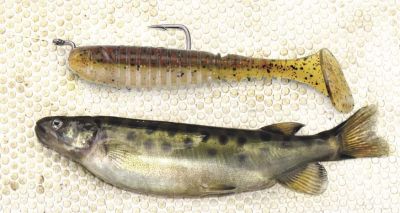 |
|
Rapala 9cm Scatter Pop Large lures and plastics |
Gear
This is an artificial lure or fly water only. Whatever method you choose I suggest heavy fluorocarbon leaders as in the turbid water they wont be seen. Whilst small lures, plastics and wet flies may work there is no need to go small. Whatever it is though make sure is has profile and action.
The Crescent fish cannot just rely on sight to catch their food and probably more than in most other Tasmanian waters use their lateral lines to pick up vibrations and movement of their prey. A lure, plastic or fly that has action stands a much bigger chance of success than one that just glides through the water.
Big lures are my preferred option, they should float or suspend, have a good strong profile and have a rolling, wobbling action that works on a really slow retrieve. The new 9cm Rapala Scatter Rap (yellow perch or silver) is perfect here and has all the attributes you need, as does a Berkley 4.5 Ribbed Shad in a dark colour.
Because a slow retrieve is favoured lures or flies that sink too quickly will hook the bottom and not much else. Being able to control the depth you are fishing at is of prime importance.
Remember at full supply the deepest part of the lake is barely two metres deep. Four to six kilo fluorocarbon tippet is not too heavy and a two metre or so 2-4 kg rod will suffice. Reels around 2-4000 are plenty and loaded with braid is ideal.
A fly rod that will deliver a big, but not heavy, fly is all you need - anything from a six to eight weight will do and a floating, ghost or slow intermediate line. A reel with a good drag may help, but often these big fish don’t fight much.
Method
Whatever method - fly, soft plastic or lure, fish slowly. Slowly fished surface lures offer an exciting opportunity to target the big trout in the channels and inlets along the front of the marshes and off the rocky edges particularly in the low light conditions early and late in the day. Similarly surface fished flies made of deer hair and foam will draw attention from the
Crescent monsters
Whilst there are some opportunities from the shore most will opt for a boat as it gives great access drifting along the productive shores and fishing back into the marshes. A point to note though is that when this lake was mostly fished using baits anglers rowed their baits out 100 metres or more. Now anglers fish back in towards the shore. What do you make of that? I am not sure.
For those wanting to stay overnight there are lovely camp grounds nearby at Dago Point, Lake Sorell. The lake has only one boat ramp situated at the outflow canal where it enters the Clyde River. The ramp is concrete and allows the launching of reasonable sized boats.
As previously mention the lake is fairly shallow, it can get surprisingly rough and there are reefs out where you wouldn’t expect them. So err on the side of caution and take care while boating.
This lake has shown that it is vulnerable to drought conditions which make it difficult to fish so with the high lake levels that currently exist if you are after a trout of a life time NOW is the time to fish Lake Crescent.
Lake Crescent Angling Regulations See https://www.ifs.tas.gov.au/about-us/publications/lake-crescent-angler-access-fact-sheet
Mike Stevens
These three fish weighed in at a total of around 30 pound
